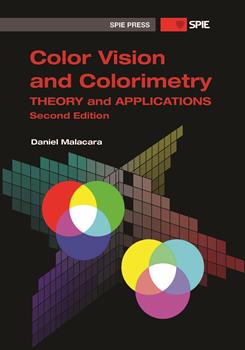|
In the procedure for finding color-matching functions described in Chapter 4, a practical problem appears. For some wavelengths of the monochromatic reference, after decreasing the luminance of the red beam in the matched zone to zero, the color may still look too red. The only solution in order to achieve a perfect match is to add red to the reference zone, instead of taking it from the sample, which is impossible. Mathematically, this can be considered as subtracting red light from the sample, which means that this color-matching function value is negative. A set of three stimuli (X, Y, and Z) is defined by a linear combination of the red, green, and blue stimuli, some of which are negative. This transformation is accomplished by means of a projective transformation (Ives, 1915, 1923), transforming the system of coordinates (r, g, b) into a new system of coordinates (x, y, z), whose properties will be defined below. The curve of spectrally pure colors r(λ), g(λ), b(λ) transforms into a curve of spectrally pure colors defined by x(λ), y(λ), z(λ) (dependence on λ omitted for simplicity): (5.1) where (rx; gx;; bx) are the coordinates of the point (x = 1; y = 0; z = 0), (ry; gy; by) are the coordinates of the point (x = 0; y = 1; z = 0), and (rz; gz; bz) are the coordinates of the point (x = 0; y = 0; z = 1) as measured in the system r, g, b. Now assume that the inverse of this matrix is A, so that we can write (5.2) The type of linear transformation is determined by the values of these coefficients. |
|
|


